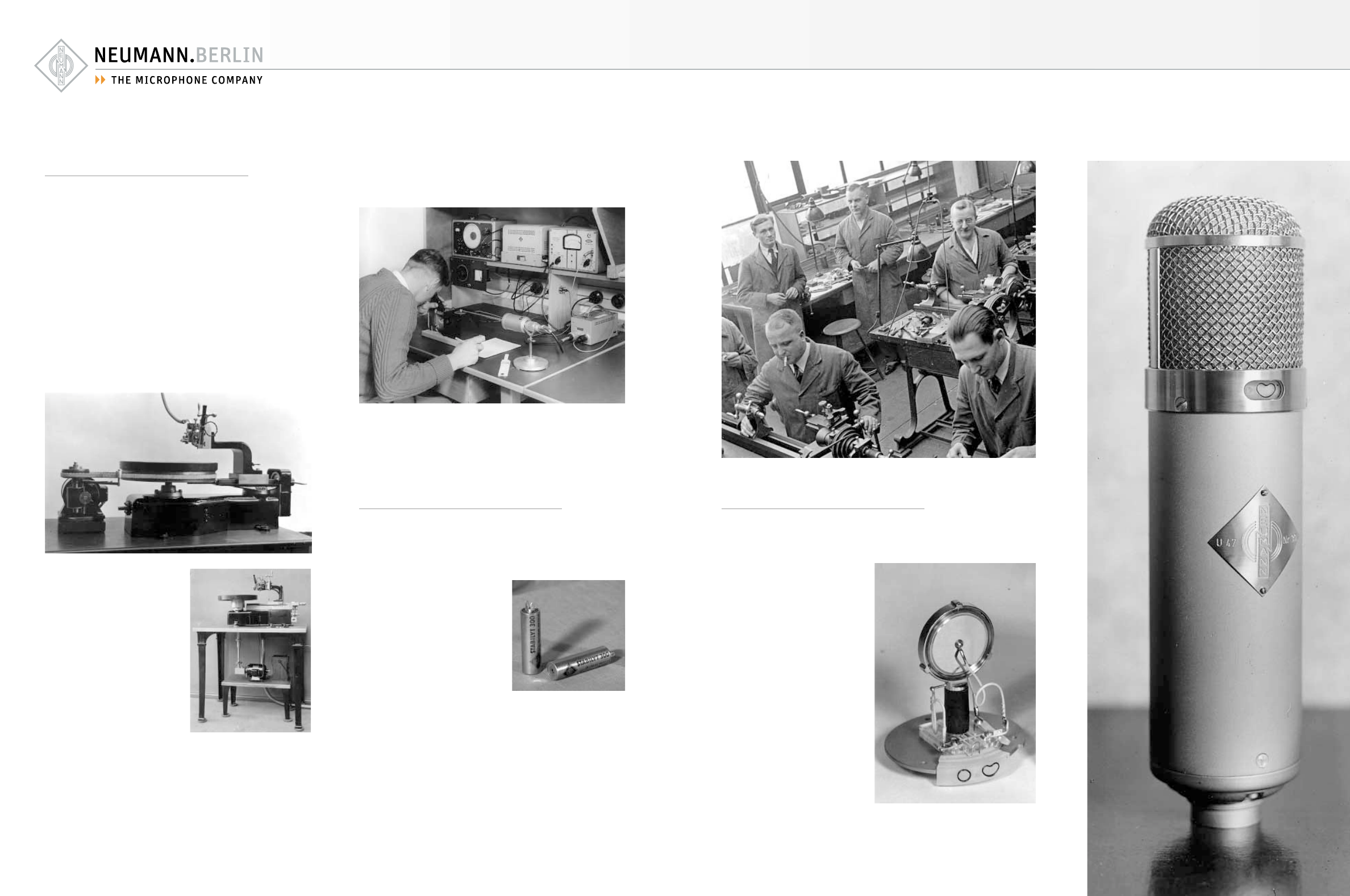
Neumann History
54
More than Just Microphones ...
By 1928 Neumann had spread his attention to
other aspects of studio engineering, such as
record making. It was his interest in record tech-
nology that was, in fact, the real reason for the
split with Eugen Reisz.
His enthusiasm and Reisz’ opposition were
stirred by a commission from Neumann’s friends
in England to build a machine for cutting
records. This machine was to become the basis
for Georg Neumann & Co’s secondary line of
products.
The earliest disc cutting machines were belt
driven. The head was moved forward by a spin-
dle, which was itself driven via
a worm gear and a further gear
from the base of the turntable.
The obvious parallel between
this configuration and later
record playing deck is particu-
larly significant when it is con-
sidered that by 1930 Neumann
had already made the transi-
tion from belt drive to direct
drive with the motor acting as
a direct extension of the turn-
table spindle.
Throughout the ’30s and early
’40s the company began to take on a recognis-
able shape. Diversification brought continued
innovation, ranging from electro-acoustic meas-
urement equipment to cinema gongs and sta-
tion identification code signals (used by broad-
casting companies to broadcast their station
identification) to standard linear microphones.
Neumann also developed a pistonphone for cali-
brating both standard and pressure microphones.
The pistonphone generated a sound pressure
which could be controlled optically with great
accuracy within the 20 Hz to 600 Hz range via
the movement of a piston which displaces a giv-
en volume of air. The amplitude of the piston
was observed through a microscope, enabling
the microphones to be calibrated to an excep-
tionally high degree of accuracy.
His Most Important Invention?
It was during the course of this widening de-
velopment work that Georg Neumann made his
most important contribution to modern electri-
cal engineering. In 1947 he de-
veloped a process by which
nickel-cadmium batteries could
be made without the excessive
formation of gas and so totally
gas tight – an invention that has
direct links with virtually every
modern electronic apparatus.
Flash units, hearing aids, camer-
as, radios, etc, all rely on minute
nickel-cadmium batteries, whose
availability is the result of this
development.
One of the by-products of Neumann’s process
were stability cells, containing a cathode con-
sisting essentially of cadmium, cadmium oxide
and a nickel anode. These cells had a compara-
tive capacitance of 100 to 160,000 µF at a fre-
quency of 50 Hz, depending on the size of the
cell, and Neumann was able to use them to sta-
bilise the heating voltage for condenser micro-
phones.
Their outstanding filtering capacity was ex-
tremely useful for filtering the heating current,
particularly for directly heated tubes.
The Big Success
In retrospect, 1947 was a prolific year for the
Neumann company. On top of one major discov-
ery the company launched the
microphone that has probably
had the greatest influence in the
development of modern studio
microphone technology. The U 47
was the first switchable pattern
condenser microphone. Its im-
pact, especially in America, was
such that the dominance of
RCA’s ribbon microphone as the
studio standard was eclipsed.
The U 47 had a double diaphragm
capsule. Both diaphragms could
be polarised with the same volt-
age or neutralised with respect
to the centre electrode, so that
the omnidirectional and cardio-
id characteristics were adjusta-
ble. A ‘special’ (U 48) was also
produced, in which the dia-
phragms could be polarised with
opposite voltages with respect to the centre elec-
trode, so that it was possible to switch between
cardioid and figure-of-eight directional charac-
teristics.















